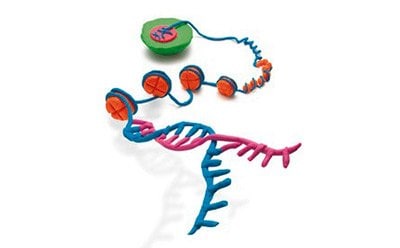Epigenetics

Epigenetics describes changes that are stable, but potentially reversible alterations in gene expression, that occur without permanent changes in DNA sequence and can still be passed on from generation to generation. Epigenetically controlled genes are activated or repressed without any change in DNA. Three central epigenetic mechanisms that play an essential role in gene regulation have been extensively studied by researches, including DNA methylation, histone modification, and RNA regulation. Our combined comprehensive epigenetics portfolio offers high quality products to perform the techniques used to study all the three central epigenetic mechanisms.
Products
Histone Modification
Chromatin is the complex of genomic DNA and associated proteins in the nucleus. Modifications to chromatin structure and the interplay of chromatin proteins play a direct role in epigenetic regulation. The structure of chromatin is facilitated by histones, a major class of chromatin proteins. Histones form the nucleosome, a complex containing 2 subunits each of histones H2A, H2B, H3 and H4. On the outside of the core complex, linker histone H1 occupies the internucleosomal DNA. This nucleosome complex maintains the compacted structure of chromatin. Site-specific histone modifications, such as methylation, acetylation, phosphorylation, ubiquitination, and citrullination, can alter local chromatin structure and regulate transcription, repair, recombination, and replication. Non-histone proteins associated with chromatin are a diverse group with thousands of different protein types, including transcription factors, polymerases, hormone receptors and other nuclear enzymes.
DNA Methylation
DNA methylation is an important epigenetic mechanism regulating gene silencing, imprinting, embryonic development, and chromosome stability. DNA methylation occurs on the 5-carbon position of cytosine residues mainly within CpG dinucleotides to form 5-methylcytosines (5-mC). The reaction is catalyzed by DNA methyltransferases (DNMTs). 5-methylcytosines residues may also be hydroxylated by TET enzymes to form 5-hydroxymethylcytosine (5-hmC), which has differing roles from 5-mC. We provide robust tools that enable you to not only detect and quantify 5-mC and 5-hmC, but also to accurately distinguish between these modifications.
Chromatin Immunoprecipitation (ChIP) Kits
Quantitative detection of histone modifications is important to a better understanding of epigenetic regulation of cellular processes in normal or cancer tissues. The most widely used techniques to study how histone modifications and other DNA binding proteins, such as transcription factors, influence gene expression is called chromatin immunoprecipitation (ChIP) combined with qualitative polymerase chain reaction (qPCR). ChIP involves chemically crosslinking proteins to DNA sequences, which is followed by immunoprecipitation of the crosslinked complexes by using antibodies and beads to pull down the modified histone or other proteins of interest. The most commonly studied and best understood histone modifications are acetylation, phosphorylation, methylation, and ubiquitination. Histone modifications regulate DNA transcription, repair, recombination, and replication, and can alter local chromatin architecture. Explore our wide range of kits for analyzing complex histone modifications patterns.
Transcriptional and Post-Transcriptional Control: RNA Regulation
Traditionally, gene expression research has focused on transcriptional regulation through the interactions of transcription factors with specific binding sites, modifications of histones within chromatin, and coordinate chromatin dynamics associated with changes in gene transcription. Today’s gene expression research seeks to understand the dynamics of RNA regulation, with the ultimate goal of bridging the gap between transcriptional control and protein expression. RNA-binding proteins (RBPs) play a key role in post-transcriptional regulation of gene expression.
RNA Regulation: RNA-binding Protein Immunoprecipitation (RIP) Kits
RIP can be viewed as the RNA analog of the more well-known ChIP application. RIP can be used to identify specific RNA molecules associated with specific nuclear or cytoplasmic binding proteins. RIP begins with immunoprecipitation of endogenous complexes of RNA binding proteins and co-isolation of RNA species associated with the immunoprecipitated complex. After purification of these RNA species, they can be interrogated and identified as mRNAs or non-coding RNAs by a variety of applications including quantitative RT-PCR, microarray analysis (RIP-Chip) and high throughput sequencing (RIP-Seq).
Related Resources
- Article: ChIC/CUT&RUN Kits
Chromatin Immunocleavage (ChIC) kits and CUT&RUN technology overview for improved chromatin isolation and downstream analyses.
- Article: RNA Immunoprecipitation Chip (RIP) Assay
RNA Immunoprecipitation (RIP) is an essential method for analyzing proteins that interact with and modify the function of mRNAs, small RNAs, viral RNAs, or lncRNAs.
- Article: Chromatin Immunoprecipitation (ChIP) Assay
Use chromatin immunoprecipitation (ChIP) to detect and relatively quantify specific protein-DNA and protein-protein interactions in vivo at a single locus or multiple loci.
To continue reading please sign in or create an account.
Don't Have An Account?